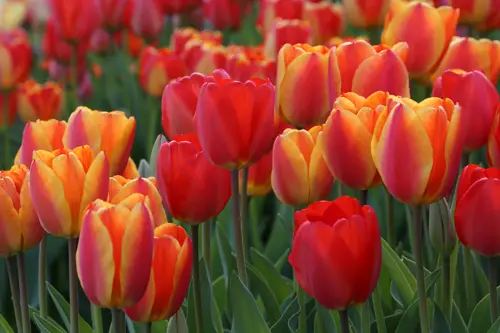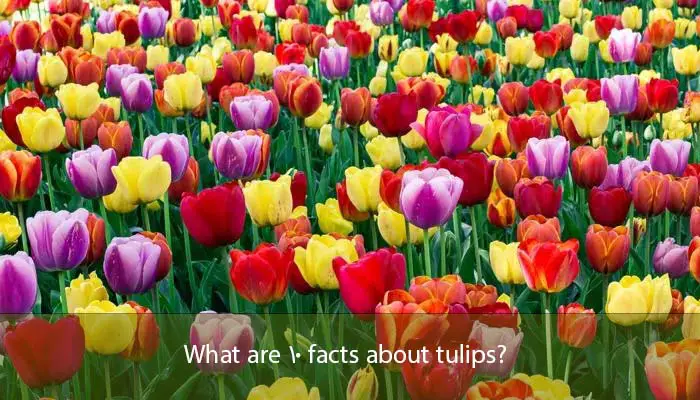What are 10 facts about tulips?
Tulip cultivation began in Persia in the 10th century and became a symbol of the Ottoman Empire. It was introduced to the Western world by Augier Ghislain de Busbecq, who wrote about seeing the plants in Turkey in 1551 and sent seeds to Austria. The arrival of tulip bulbs in Antwerp in 1562 marked the beginning of the horticultural tulip industry in Europe. French botanist Carolus Clusius was an early recipient of these flowers, and in the 1590s, he established a botanic garden at the University of Leiden. The tulip Mania in the Netherlands in 1633-37 is now known.
In addition to tulips, you can read “apartmentflowers” site blogs to learn about other apartment flowers!

1. Tulips are native to Central Asia
Tulips, native to the Tien Shan Mountains in central Asia, were introduced to the Ottoman Empire by 1000 A.D., where they were cultivated in parks and palace gardens, spreading westward.
2. The tulip industry got its start in Holland
In the 1500s, Dutch botanist Carolus Clusius received tulip bulbs from the ambassador to the sultan, but refused to share or sell them. This led to gardens being raided and the tulip industry in Holland being born.
3. Tulip Mania is one of the most famous market crashes of all time
The tulip craze in Holland, known as Tulip Mania, saw a surge in speculators buying tulip bulbs, aiming to sell them at a high price. However, in 1637, the market crashed due to too many speculators selling at once, ending a brief but memorable period in Holland’s tulip industry.
4. Holland is still the largest producer of tulips
Tulip Mania ended in 1637, but fascination with tulips grew into a commercial enterprise, making Holland the world’s largest producer, exporting 3 billion bulbs annually.
5. Each color tulip carries its own significance
Tulips symbolize love, with red being the most romantic. White tulips convey apology, purple symbolizes royalty, and yellow is for cheer and happiness. The color of a tulip can also indicate the intended message.
6. Striped tulips were originally created from a virus
Tulips, known for their solid and striped colors, were highly valued since the 1600s. However, in 1931, scientists discovered a virus caused by aphids, leading to the discovery of artificial reproduction of this coloring. Today, the virus is used to alter DNA without aphids.
7. Tulips inspired many forms of art
Tulips have been prominently featured in Islamic art since the sultans’ time. German painter Jacob Marrel’s book of paintings inspired textile and furniture designs. The Dutch Old Masters’ still-life paintings also featured tulips. Tulips became a popular subject in the Arts and Crafts movement in the mid-1800s, with Tiffany tulip lamps produced in the late 1800s.
8. The word ‘tulip’ comes from a Persian word meaning ‘turban’
The word “tulip” originates from the flower’s graceful shape and bulb, which inspired the Turkish pronunciation of “tülbend,” which means turban.
9. Keukenhof is the largest tulip garden in the world
Keukenhof in Holland is a world-renowned garden, home to the world’s largest tulip garden, which blooms over 7 million tulips in April and May.
10. There are thousands of varieties of tulips
Over 3,500 named tulips are divided into 15 groups: single early, double early, triumph, Darwin hybrid, single late group, lily-flowered, fringed, viridiflora, Rembrandt, parrot, double late, Kaufmanninana, Fosteriana, Greigii, and miscellaneous. Single early tulips have short, round flowers, double early tulips have larger, double-flowered flowers, triumph tulips have sturdy mid-season tulips, Darwin hybrid tulips have large-flowered tulips on tall stems, lily-flowered tulips have graceful, tall-stemmed flowers, fringed tulips, viridiflora tulips, Rembrandt tulips, Parrot tulips, double late tulips, Kaufmanninana tulips, Fosteriana tulips, and Greigii tulips.

What is special about tulip?
Captivated by the alluring tulip flower? You are not at fault! Here are a few interesting and unique tulip-related facts.
They are renowned for having exquisitely symmetrical flower buds. These are the flowers on an 11th wedding anniversary. Edible tulip petals can be used in place of onions in a variety of recipes, including ones that call for making wine. The blooms were more valuable than diamonds during the height of the tulip craze. Over 150 species and a startling 3000 variants of tulips exist.

Why are tulips great?
Since tulips are so abundant, readily available, tidy, lovely, and reasonably priced (a dozen in European supermarkets typically costs around €2,50; a quality tulip bulb seldom costs more than 40 or 50 cents), some horticulturists think tulips are overtaking roses as the most popular flower in the world.
Why is a tulip called a tulip?
The tulip, a symbol of power and wealth, became popular among Ottoman sultans, who wore tulips on their turbans. The name tulip comes from the Persian word ‘tulipan’, meaning turban. Sultan Suleyman the First gifted tulips to important guests, including Ogier Ghiselin de Busbecq, the Viennese ambassador to the Ottoman Empire. In Austria, de Busbecq gifted tulips to Carolus Clusius, who managed the gardens of the Emperor of Austria. In 1593, Clusius became a professor at Leiden University and head of the Hortus Botanicus Leiden, where the first tulips were planted in the Netherlands.
Conclusion
Tulips are a popular garden plant due to their sturdy, tall, and bright blooms that can bloom multiple times in a row, with varying leaf colors from green to gray-green to variegated lance-shaped.
| Common Names: | Tulip, Tulipa |
| Botanical names: | Tulipa, (TEW-li-pa) |
| Availability: | November through May; limited availability year round |
| Vase life: | 3 to 7 days |
| Storage temperatures: | 32 – 34 degrees Fahrenheit |
| Ethylene Sensitive: | No |
| Description: | Deep cup-shaped blossoms, 2 to 4 inches high born on solid stems 12 to 24 inches high. Tulip blossoms are grouped into four categories; single-rounded, double-rounded, parrot (fringed), and lily flowered (pointed petals). |
| Color: | Red, pink, white, yellow, orange, purple and bi-colors |
Know more: DO TULIPS BLOOM MORE THAN ONCE?











